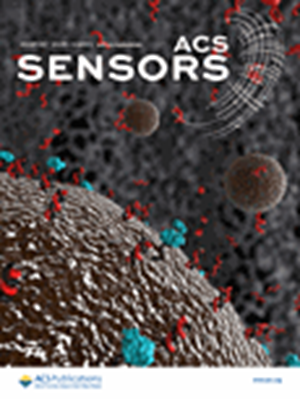基于活动的 19F-MRI Zn2+ 活性特异性传感器
IF 9.1
1区 化学
Q1 CHEMISTRY, ANALYTICAL
引用次数: 0
摘要
生物系统中金属离子水平的快速波动比绘制专为阳离子 19F-MRI 设计的含氟传感器所需的时间更快。一种有吸引力的模块化解决方案可能来自基于活性的传感方法。在这里,我们提出了一种高活性但最终仍具有特异性的合成含氟传感器,用于绘制易溶 Zn2+ 的 19F-MRI 图谱。该传感器由一个用于识别 Zn2+ 的二羟基胺支架和一个乙酸氟苯酯实体组成。与 Zn2+ 结合后,合成传感器很容易水解,其 19F-NMR 中 19F 功能基团的频率会偏移 12 ppm,从而以人工核磁共振成像彩色图的形式显示 Zn2+ 的分布,突出了其与其他金属离子相比的特异性。Zn2+ 引发的不可逆水解会导致 19F-MRI 的 "开启",即使在阳离子水平短暂升高时也能检测到它。我们设想可以根据这项工作中展示的原理开发出更多的金属离子传感器,从而扩大目前用于 19F-MRI 的分子工具箱。本文章由计算机程序翻译,如有差异,请以英文原文为准。

A Reactive and Specific Sensor for Activity-Based 19F-MRI Sensing of Zn2+
The rapid fluctuations of metal ion levels in biological systems are faster than the time needed to map fluorinated sensors designed for the 19F-MRI of cations. An attractive modular solution might come from the activity-based sensing approach. Here, we propose a highly reactive but still ultimately specific synthetic fluorinated sensor for 19F-MRI mapping of labile Zn2+. The sensor comprises a dipicolylamine scaffold for Zn2+ recognition conjugated to a fluorophenyl acetate entity. Upon binding to Zn2+, the synthetic sensor is readily hydrolyzed, and the frequency of its 19F-functional group in 19F-NMR is shifted by 12 ppm, allowing the display of the Zn2+ distribution as an artificial MRI-colored map highlighting its specificity compared to other metal ions. The irreversible Zn2+-induced hydrolysis results in a “turn-on” 19F-MRI, potentially detecting the cation even upon a transient elevation of its levels. We envision that additional metal-ion sensors can be developed based on the principles demonstrated in this work, expanding the molecular toolbox currently used for 19F-MRI.
求助全文
通过发布文献求助,成功后即可免费获取论文全文。
去求助
来源期刊

ACS Sensors
Chemical Engineering-Bioengineering
CiteScore
14.50
自引率
3.40%
发文量
372
期刊介绍:
ACS Sensors is a peer-reviewed research journal that focuses on the dissemination of new and original knowledge in the field of sensor science, particularly those that selectively sense chemical or biological species or processes. The journal covers a broad range of topics, including but not limited to biosensors, chemical sensors, gas sensors, intracellular sensors, single molecule sensors, cell chips, and microfluidic devices. It aims to publish articles that address conceptual advances in sensing technology applicable to various types of analytes or application papers that report on the use of existing sensing concepts in new ways or for new analytes.
 求助内容:
求助内容: 应助结果提醒方式:
应助结果提醒方式:


